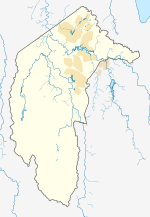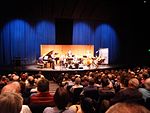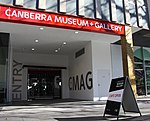Canberra Centenary Column

The Canberra Centenary Column is a sculpture in City Hill, Canberra, Australia. It was built to commemorate the city's centenary, and unveiled on 11 March 2014.The sculpture is an 8.5-metre (28 ft) stainless steel obelisk on a 5-metre-wide (16 ft) granite-dressed concrete base. The top of the base is inlaid with glass tiles and has a steel covering etched with images depicting Canberra's 100-year history. It was designed by local artist Geoff Farquhar-Still. The design was inspired by the "Commencement Column" that was proposed to have been built when Canberra was founded, but was never completed.Encased in the base is a time capsule containing one hundred objects, both symbolic and mundane. The time capsule is intended to be opened in 100 years, during Canberra's bicentenary. The ACT Heritage Library and the National Film and Sound Archive have catalogues of the capsule's contents, and copies of some of the items.
Excerpt from the Wikipedia article Canberra Centenary Column (License: CC BY-SA 3.0, Authors, Images).Canberra Centenary Column
Vernon Circle, Canberra City
Geographical coordinates (GPS) Address External links Nearby Places Show on map
Geographical coordinates (GPS)
| Latitude | Longitude |
|---|---|
| N -35.28143 ° | E 149.12921 ° |
Address
Centenary Obelisk
Vernon Circle
2601 Canberra, City
Australia
Open on Google Maps







